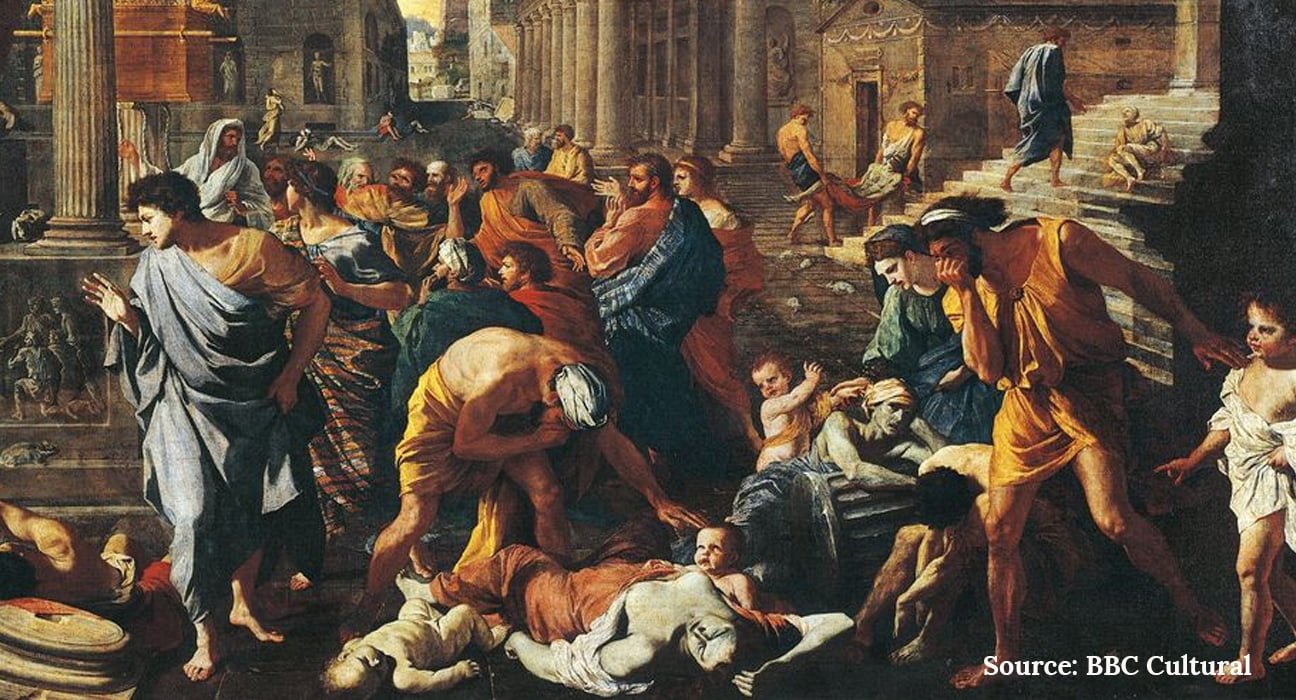Plague paintings, with their vivid depictions of death, despair, and disease, bear witness to the darkest chapters in human history. Yet, within these haunting scenes, there is an undercurrent of resilience that speaks to the indomitable spirit of the human condition. These works of art reveal the complex interplay of fear, suffering, hope, and determination that defined the psychological landscape of individuals and communities grappling with the horrors of pandemics.
The Bubonic Plagues
This article delves into plague and resilience by taking into account the bubonic plague outbreak that was marked as one of history’s most dreadful plague outbreaks. The first bubonic plague outbreak was in 541 CE, in the Byzantine Empire. Outbreaks continued to occur for the next two centuries and the next great plague pandemic occurred in the fourteenth century with the Black Death of 1348 and another great pandemic in the seventeenth century with the Plague of Naples (1656-1658) and the Great Plague of London (1665-1666).
The imagery of plague manifests in the form of religious and spiritual beliefs of the people, their own grief and traumatic experience, and lastly, their expectations and hope for survival from the disease. Historic artworks from times of rampant disease and suffering provide a unique look into the human psyche and how people can endure and bounce back from catastrophes.
Resilience
What is Resilience? Resilience refers to the ability to bounce back, after any adversity or trauma and adapt to the circumstances presented. It’s a set of emotional, behavioural and cognitive responses to stressors in the midst of a crisis. Inner resilience is a valuable quality that seems to be the key to both excellent mental health and success in the outside world (Neenan, 2018).
Read: Resilience
The term resilience is used in physical sciences to describe a material that has the ability to bounce back to its original shape after being manipulated. Similarly, the “ability to remain flexible in our thoughts, feelings, and behaviours when faced with life disruption, or extended periods of pressure, so that we emerge from difficulty stronger, wiser, and more able” (Pemberton, 2015) is the definition of resilience in the human context.
Plague Paintings and Depictions of Resilience
The effects of the black plague were huge. It is said to have wiped out at least 30-60% of the European population. The era of the black plague highlights the ability of humans to navigate the darkest and most despairing moments in human history. Yet we are able to see a glimpse of resilience in the art produced during these periods. People’s response to the Black Plague was not a descent into despair and helplessness. Instead, their resilience shone through as they fought to assert life’s glory, as depicted in the plague paintings.
Plague, Poussin and Early Modern Medicine
In her article Plague, Poussin and Early Modern Medicine, Sheila Barker suggests that Nicolas Poussin designed his painting The Empire of Flora “to instigate a metamorphosis from sickness to health in the viewer”. The garden setting of his work aids in reinforcing a positive, healthful effect through the pleasant views and fragrances of the trees and flowers in it, a welcome change in comparison to the angst-ridden stench of plague miasmas. Barker also believes that the positioning of Phoebus Apollo above Flora’s garden serves as a means of psychosomatic healing.
Read: Emotional Weakness: Causes, Signs and Tips
Further, she mentions the depiction of various anti-pestilential flowers in the garden such as roses, hyacinths, violets and narcissus. These further add to the perception that the air in the garden was purified by the flowers it housed. This painting was presumed to be Poussin’s attempt to provide psychological healing for his patrons through visual appeasement.
Themes
Social networks and support systems are essential components of resilience. Plague paintings frequently highlight the importance of social ties in fostering resilience by showcasing the strength of relationships and community in the face of extreme adversity. An important element of resilience is post-traumatic growth. It is the transformative aspect of resilience and refers to when individuals emerge from adversity with a deeper sense of purpose and appreciation for life.
This post-traumatic growth can be seen as one of the central themes in post-plague paintings. The art in the 15th and 16th centuries mainly portrays an abounding imagery of death, but there are also paintings and artwork depicting joy and optimistic messages. Rather than being discouraged by the plague, they seem to have been inspired to celebrate life’s splendour.
The collection of plague paintings also includes art made specifically to immortalise the loved ones that the artists lost during the plague. Human Frailty by Salvator Rosa is one such example. Rising from the ashes of the plague was the emergence of artists like Lorenzo Ghiberti (1378-1455) and Alberti, who are renowned for their Renaissance art. Fitting was the term, renaissance—Rebirth.
Conclusion
Analyzing paintings from the fourteenth to seventeenth century allows one to know about the various aspects of grief experienced during the plagues. Whether it was immortalizing a loved one lost at the hands of a vicious disease or simply coming to terms with the fact that death was a common denominator amongst all members of society, artists managed to perfectly encapsulate their emotions in their timeless works of art. The iconography of death in all its glory reflects not only people’s fear of the widespread disease but also their passion for life and the bitterness that comes with losing it.













Leave feedback about this